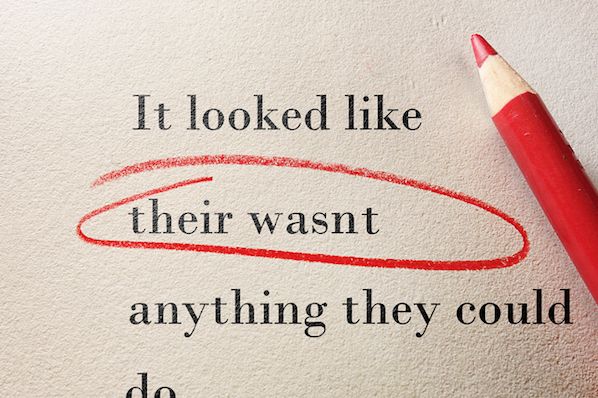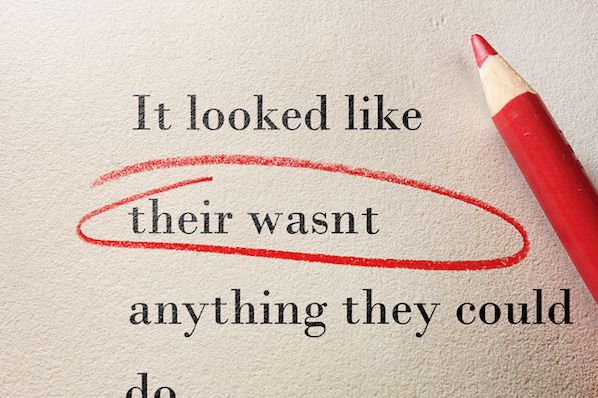It's Incomplete Comparisons Passive Voice Dangling Modifiers Referring to a Brand or Entity as 'They' Possessive Nouns Affect vs. Effect Me vs. Fewer Semicolons Compliment vs. Complement Farther vs. Further En Dash vs. Em Dash Title Capitalization Between vs. Lots of people get tripped up because "it's" has an 's after it, which normally means something is possessive. Passive happens when the object of a sentence is put at the beginning of a sentence instead of at the end. "To" is typically used before a noun or verb, and describes a destination, recipient, or action. They're often confused, but "into" indicates movement (Lindsay walked into the office) while "in to" is used in lots of situations because the individual words "to" and "in" are frequently used in other parts of a sentence. * In the sentence above, "then" should be "than." "Then" is mainly an adverb used to situate actions in time: We made dinner, and then we ate it. Since it's so common for us to throw around fake worlds like "shoulda," the above mistake is an easy one to make -- "shoulda" sounds like a shortened version of "should of." "To ensure" means to make certain.

Even after years of education, there are some things that some people still mess up. For me, it’s algebra. For others, it’s the laws of physics. And for many, it’s grammar.
It’s not easy. Words and phrases that sound fine in your head can look like gibberish when written down — that is, if you even realize you made a mistake in the first place. It’s easy for little grammar mistakes to slip by, especially when you’re self-editing.
But how do you prevent grammatical errors if you’re not even aware you’re making them?
Well, you can start by reading through this post to see which common grammar mistakes resonate with you the most. (It’s okay — we’re all guilty of at least one.) Make a mental note to avoid that mistake in the future, or heck, just bookmark this page to remind yourself of them over and over (and over) again.

Common Grammar Mistakes
- They’re vs. Their vs. There
- Your vs. You’re
- Its vs. It’s
- Incomplete Comparisons
- Passive Voice
- Dangling Modifiers
- Referring to a Brand or Entity as ‘They’
- Possessive Nouns
- Affect vs. Effect
- Me vs. I
- To vs. Too
- Do’s and Don’ts
- i.e. vs. e.g.
- Peek vs. Peak vs. Pique
- Who vs. That
- Who vs. Whom vs. Whose vs. Who’s
- Alot vs. A lot vs. Allot
- Into vs. In to
- Lose vs. Loose
- Then vs. Than
- Of vs. Have
- Use of Commas
- Assure vs. Insure vs. Ensure
- Less vs. Fewer
- Semicolons
- Compliment vs. Complement
- Farther vs. Further
- En Dash vs. Em Dash
- Title Capitalization
- Between vs. Among
1. They’re vs. Their vs. There
One’s a contraction for “they are” (they’re), one refers to something owned by a group (their), and one refers to a place (there). You know the difference among the three — just make sure you triple check that you’re using the right ones in the right places at the right times.
I find it’s helpful to search through my posts (try control + F on PC or command + F on Mac) for those words and check that they’re being used in the right context. Here’s the correct usage of “they’re,” “there,” and “their”:
They’re going to love going there — I heard their food is the best!
2. Your vs. You’re
The difference between these two is owning something versus actually being something:
You made it around the track in under a minute — you’re fast!
How’s your fast going? Are you getting hungry?
See the difference? “Your” is possessive and “you’re” is a contraction of “you are.”
Again, if you’re having trouble keeping them straight, try doing another grammar check before you hit publish.
3. Its vs. It’s
This one tends to confuse even the best of writers. “Its” is possessive and “it’s” is a contraction of “it is.” Lots of people get tripped up because “it’s” has an ‘s after it, which normally means something is possessive. But in this case, it’s actually a contraction.
Do a control + F to find this mistake in your writing. It’s really hard to catch on your own, but it’s a mistake everyone can make.
4. Incomplete Comparisons
This one drives me up a wall when I see it in the wild. Can you see what’s wrong with this sentence?
Our car model is faster, better, stronger.
Faster, better, stronger … than what? What are you comparing your car to? A horse? A competitor’s car? An older model?
When you’re asserting that something should be compared to something else, make sure you always clarify what that something else is. Otherwise, it’s impossible for your readers to discern what the comparison actually means.
5. Passive Voice
If you have a sentence with an object in it — basically a noun that receives the action — passive voice can happen to you. Passive happens when the object of a sentence is put at the beginning of a sentence instead of at the end. With passive voice, your writing comes across as sounding weak and unclear.
Hold up. Re-read that last paragraph I just wrote:
“… Passive happens when the object of a sentence is put at the beginning of a sentence instead of at the end …”
There’s way too much passive voice. See how the sentence doesn’t have a subject that’s acting upon the object? The object is mysteriously being “put at the beginning,” making the sentence sound vague and clunky.
Passive voice happens when you have an object (a noun that receives the action) as the subject of a sentence. Normally, the object of the sentence appears at the end, following a verb. Passive writing isn’t as clear as active writing — your readers will thank you for your attention to detail later.
Let’s try that again, using active voice:
Passive happens when the writer puts the object of a sentence at the beginning, instead of at the end.
In this example, the sentence correctly uses a subject, “the writer,” to actively describe the object.
Make sense? It’s kind of a complicated thing to describe, but active voice makes your writing seem more alive and clear. Want to get into the nitty-gritty of avoiding passive voice? Check out this tip from Grammar Girl.
6. Dangling Modifiers
I love the name of this mistake — it makes me think of a dramatic, life-or-death situation such as hanging precariously off a cliff. (Of course grammar mistakes are never that drastic, but it helps me remember to keep them out of my writing.)
This mistake happens when a descriptive phrase doesn’t apply to the noun that immediately follows it. It’s easier to see in an example taken from my colleague over on the HubSpot Sales Blog:
After declining for months, Jean tried a new tactic to increase ROI.
What exactly is declining for months? Jean? In reality, the sentence was trying to say that the ROI was declining — not Jean. To fix this problem, try flipping around the sentence structure (though beware of passive voice):
Jean tried a new tactic to increase ROI after it had been declining for months.
Better, right?
7. Referring to a Brand or Entity as ‘They’
A business ethics professor made me aware of this mistake. “A business is not plural,” he told our class. “Therefore, the business is not ‘they.’ It’s ‘it.'”
So, what’s the problem with this sentence?
To keep up with their changing audience, Southwest Airlines rebranded in 2014.
The confusion is understandable. In English, we don’t identify a brand or an entity as “he” or “she” — so “they” seems to make more sense. But as the professor pointed out, it’s just not accurate. A brand or an entity is “it.”
To keep up with its changing audience, Southwest Airlines rebranded in 2014.
It might seem a little strange at first, but once you start correctly referring to a brand or entity as “it,” the phrasing will sound much more natural than “they.”
8. Possessive Nouns
Most possessive nouns will have an apostrophe — but where you put that apostrophe can be confusing. Here’s an example of possessive nouns used incorrectly:
All of the lizard’s tails grew back.
In this sentence, “all” implies there’s more than one lizard, but the location of the apostrophe suggests there really is just one.
Here are a few general rules to follow:
- If the noun is plural, add the apostrophe after the s. For example: the dogs’ bones.
- If the noun is singular and ends in s, you should also put the apostrophe after the s. For example: the dress’ blue color.
- On the other hand, if the noun is singular and doesn’t end in an s, you’ll add the apostrophe before the s. For example: the lizard’s tail.
Simple, right? If you want a deeper dive into the rules of possessive nouns, check out this website.
9. Affect vs. Effect
This one is another one of my pet peeves. Most people confuse them when they’re talking about something changing another thing.
That movie effected me greatly.
Effect, with an “e,” isn’t used as a verb the way “affect” is, so the sentence above is incorrect. When you’re talking about the change itself — the noun — you’ll use “effect.”
That movie had a great effect on me.
When you’re talking about the act of changing — the verb — you’ll use “affect.”
That movie affected me greatly.
10. Me vs. I
Most people understand the difference between the two of these, until it comes time for them to use one in a sentence.
When you get done with that lab report, can you send it to Bill and I?
The sentence above is actually wrong, as proper as it sounds.
Try taking Bill out of that sentence — it sounds weird, right? You would never ask someone to send something to “I” when he or she is done. The reason it sounds weird is because “I” is the object of that sentence — and “I” should not be used in objects. In that situation, you’d use “me.”
When you get done with that lab report, can you send it to Bill and me?
Much better.
11. To vs. Too
We’ve all accidentally left the second “o” off of “too” when texting in a hurry. But in case the mistake goes beyond that, let’s review some usage rules.
“To” is typically used before a noun or verb, and describes a destination, recipient, or action. Take these examples:
My friend drove me to my doctor’s appointment. (Destination)
I sent the files to my boss. (Recipient)
I’m going to get a cup of coffee. (Action)
“Too,” on the other hand, is a word that’s used as an alternative to “also” or…

COMMENTS